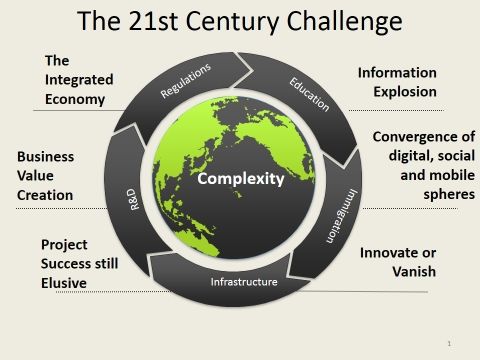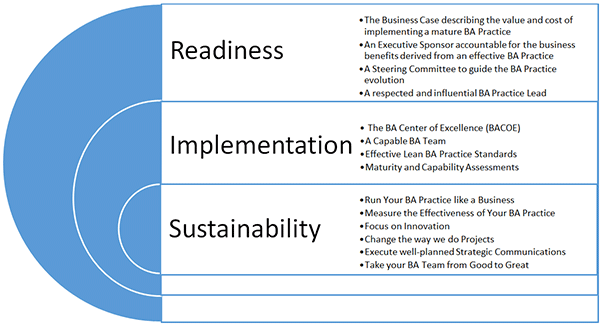
Finally! A Proven Framework to Implement Value-Based Business Analysis
Far too often, implementation of business analysis (BA) as a valued discipline within organizations is elusive. Business analysts (BAs) struggle to form BA communities, share knowledge and best practices, and improve competencies and outcomes of their efforts. These improvements will only reap limited benefits. What is needed to respond to 21st century challenges is a disciplined, value-creating BA Practice. However, we often falter when attempting to implement a formal BA discipline withing companies and non-profit agencies. It is an arduous task, a cultural change, a complex endeavor.
The 21st Century Challenge
These are tumultuous times. Businesses are faced with unprecedented challenges in the hyper-connected 21st century global economy. Extraordinary gale-force winds of change are swirling faster than ever before, causing us to rethink our approach to business, project, and performance management.
The Integrated Economy
Everyone is feeling the effects of the global integrated economy, and BAs are no exception. Many jobs are becoming commoditized; they can be performed by internal resources, contractors, or even outsourced resources located anywhere across the globe. Global wage scales have made U.S. employees too expensive to perform standard, repetitive tasks. Many U.S. jobs are gone and not coming back. For these reasons, basic BA tasks are beginning to be outsourced or performed by contractors.
The Technology and Information Explosion
IT applications have also impacted U.S. jobs by automating repetitive activities, often increasing the quality and predictability of outcomes. Smart IT applications are replacing knowledge workers across industries, including BAs. The demand for new, innovative apps delivered quickly is making traditional requirements and development methods obsolete.
Convergence of Digital, Social and Mobile Spheres
Social/mobile media has connected us all in obvious and subtle ways, some of which we don’t yet fully understand; and new applications emerge that we can’t even imagine until they reach us. As we saw across the Middle East and elsewhere, people are using social media to bring about major changes to social and political systems. BAs are using social media to enhance collaboration among key stakeholders across the globe.
Innovation vs. Business as Usual
The call to action for today’s businesses is ‘innovate or vanish’. For businesses to be competitive, they must be first to market with innovative, leading-edge products and services that are intuitive, easy to use, and offer surprising new features.
It is no longer enough for BAs to ask their business partners what they want or need. BAs must learn to foster creativity and innovation during their working sessions, continually asking the question: ‘Are we truly innovating?’
Business Value Realization
Businesses cannot afford to waste project investments or precious resource time unless there are significant business benefits in terms of innovation, value to the customer, and wealth to the bottom line. 21st century BAs understand the business value proposition, and focus on value throughout the project. BAs work with project managers to develop release plans prioritized based on business value to deliver value early and often.
Project Performance
With business success riding on innovation and first-to-market speed, we must be able to deliver new products and business capabilities on time, cost, and scope commitments. However, according to the CHAOS Manifesto 2013 by the Standish Group, technology-enabled business change initiatives are only 39 percent successful, as measured by on time, on budget, and with the full scope of functions and features.i This comes at considerable cost: real sunk costs and the cost of lost opportunity estimated to cost the U.S. economy more than $1 trillion per year.
The Fundamentals of Exceptionalism
As we are struggling to bring about positive change within our companies, and our companies are struggling with the challenges of the new economy, the nation states where our companies operate are under immense pressure to build and sustain the fundamental elements of a thriving economic culture. These involve investment in five major areas: education – to ensure the availability of a skilled workforce; immigration – to reach across the world for the best minds; infrastructure – to provide the basic services for your family and your company to operate effectively and efficiently including health care; rules and regulations – to provide an environment of fairness, and research and development – to continue to innovate and create. In the developed nations of the world, investment in these fundamentals has fallen drasticallyii. Projects are emerging at every turn to rebuild these fundamental elements of a thriving society. The result is constant change and immense complexity for individuals, families, companies, communities, states and nations.
The Onslaught of Complexity
All of these forces are influenced by the unrelenting change and unprecedented complexity that exists at all levels, globally, nationally, locally, and within projects. With complexity comes dynamic, unpredictable, adaptive change. Since projects are complex adaptive systems operating within a complex environment, typical plan-based project and requirements management practices are insufficient when attempting to bring about speed and innovation. Since we are in a new, data-driven world, virtually all business projects are now dependent on information technology (IT), and all companies are technology companies. And new technologies are complex by their very nature.
Breakthrough Practices for the 21st Century
So what does all this have to do with business analysis? The root cause of our dismal project performance is twofold, gaps in two breakthrough practices, value-based Enterprise Business Analysis and innovation-based Complex Project Management. Both of these relatively new disciplines are emerging to address our 21st century challenges. In prior publications, this author delved into enterprise business analysis and complex project management. At this point, we define the need for and a practical implementation approach for building a breakthrough value-based Business Analysis Practice within your organization. Business analysis needs a home, a center supported at the highest levels of the organization to become the strategic practice that brings about real business value.
The Future
Business analysts of the not-too-distant future must and will become visionaries, innovators, strategists, and transformational leaders, executing strategy through project results. Successful business analyst teams will learn how to embrace organizational values, empower their teams to thrive, bring customers into the change process, and drive innovation through collaboration, creativity, design principles, and global partnerships. Don’t blink, or you may miss out on this exciting business experiment.
Business analysis seems to be a self-improving discipline, and we have energizing new challenges and opportunities ahead. We need to change the way we do projects to achieve faster time to market and deliver innovative solutions that add value to the customer and wealth to the organization. Only then will we be contributing to a sustained competitive advantage for our organizations.
Traditional business analysis jobs are going away and are not coming back. BA tools are growing up, and typical BA tasks are being automated and commoditized. Instead of being regarded as documenters, BAs are being sought out to focus on strategy, value, innovation, and leadership.
Implementing a Value-Based BA Practice
So how do we make the transition from a BA discipline that is project/requirements focused to one that is adding value at the enterprise/strategy level? Breakthrough value-based business analysis centers on many of the woefully inadequate essentials of business/technology projects. It changes the focus. It strives for the following elements:
- Decision making: collaborative
- Thinking: global, holistic, strategic
- Complexity: leveraged to achieve creativity
- Leadership: shared, diverse, expert
- Teams: collaborative, high performing
- Agile Methods: adapting, experimenting, creating, visualizing
- Solutions: innovative, competitive, unsettling, disruptive
- Value: delivered often
Realizing the positive impacts of a value-based BA practice could very well mean the difference between success and failure for businesses negotiating 21st century challenges. A proven framework now exists for implementing a BA practice that is strategically positioned and value-based. BA Practice Leads need a wealth of wisdom and insight for determining organizational readiness and then implementing and sustaining a value-based BA practice.
The Framework
Finally, we have a thorough examination of how to implement strategic business analysis in organizations and make them stick.
1. Readiness: “Is our organization ready? What is the right fit?”
- The Business Case describing the value and cost of implementing a mature BA Practice
- An Executive Sponsor accountable for the business benefits derived from an effective BA Practice
- A Steering Committee to guide the BA Practice evolution
- A respected and influential BA Practice Lead
2. Implementation: “How do we build the BA practice?”
- The BA Center of Excellence (BACOE)
- A Capable BA Team
- Effective Lean BA Practice Standards
- Maturity and Capability Assessments
3. Sustainability: “How do we run our BA practice like a business?”
- Run Your BA Practice like a Business
- Measure the Effectiveness of Your BA Practice
- Focus on Innovation
- Change the way we do Projects
- Execute well-planned Strategic Communications
- Take your BA Team from Good to Great

The framework is a valuable tool for IT managers, product owners, strategists, project portfolio managers, BA managers, BA practice leads, enterprise business analysts, and anyone who wants to improve business practices. This new framework offers a stage by stage approach to ensure your BA practice is customized to your organization, becomes a lasting discipline, and adds value to your customers and wealth to the bottom line.
There is a buzz in the air about the future as business analysts continue to stand out in organizations as strategic assets. Take the lead and be your organization’s champion of a value-based, breakthrough BA practice. The Breakthrough Business Analysis Implementation Framework leads the 21st century as the proven method to implement and sustain value-based business analysis practices. The framework is based on real life success stories and case studies to ensure your BA practice is the right fit based on your culture and political situation. The Value-based BA Practice brings worth to your organization as defined by value to your customer and wealth to the bottom line. The emphasis is on running your BA Practice like a business to continue to thrive through the rough roads ahead.
Portions of this article were adapted with permission from BREAKTHROUGH BUSINESS ANALYSIS, Implementing and Sustaining a Value-based Practice by Kathleen B. Hass. ©2015 by Management Concepts, Inc. All rights reserved.
Don’t forget to leave your comments below.
i THE STANDISH GROUP, “CHAOS MANIFESTO, 2013: THINK BIG, ACT SMALL,” 2013. ONLINE AT VERSIONONE.COM/ASSETS/IMG/FILES/CHAOSMANIFESTO2013.PDF (ACCESSED JANUARY 2014): 1.
ii FRIEDMAN, THOMAS, MEET THE PRESS, (SEPTEMBER 4, 2011) ONLINE AT:
HTTP://WWW.NBCNEWS.COM/VIDEO/MEET-THE-PRESS/44391320#44391320, (ACCESSED JANUARY 2014).